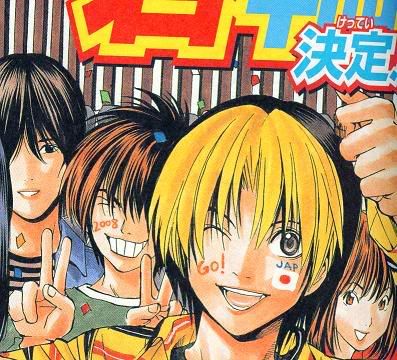Mangaka : Takeshi Obata
 Hikaru no Go (ヒカルの碁 lit. "Hikaru's Go") is a popular Japanese manga and animeboard game Go written by Yumi Hotta and illustrated by Takeshi Obata. The production of the series' Go games was supervised by Go professional Yukari Umezawa (5-dan). The manga is largely responsible for popularizing Go among the youth of Japan since its debut, and in other areas such as mainland China, Hong Kong, Taiwan, and South Korea. More recently it has gained much popularity in the United States. The title is sometimes abbreviated 'HnG'. coming-of-age story based on the
Hikaru no Go (ヒカルの碁 lit. "Hikaru's Go") is a popular Japanese manga and animeboard game Go written by Yumi Hotta and illustrated by Takeshi Obata. The production of the series' Go games was supervised by Go professional Yukari Umezawa (5-dan). The manga is largely responsible for popularizing Go among the youth of Japan since its debut, and in other areas such as mainland China, Hong Kong, Taiwan, and South Korea. More recently it has gained much popularity in the United States. The title is sometimes abbreviated 'HnG'. coming-of-age story based on the First released in Japan in Shueisha's Weekly Shonen Jump in 1998, Hikaru no Go achieved tremendous success, spawning a popular Go fad of almost unprecedented proportions; it received the Shogakukan Manga Award in 2000 and creators received Tezuka Osamu Cultural Prize in 2003 for the series. Twenty-three volumes of manga were published in Japan, comprising 189 chapters plus 11 "omake" (extra chapters). The anime series, which was created by Studio Pierrot, ran for 75 half hour episodes from 2001 to 2003 on TV Tokyo, along with the 77-minute extra New Year's Special that aired in January 2004.
Storyline
The same basic storyline is followed by the manga and anime, with a few small changes between the versions. While exploring his grandfather's shed, Hikaru stumbles across a Go board haunted by the spirit of Fujiwara no Sai, a fictional Go player from the Heian era. Sai wishes to play Go again, having not been able to since the late Edo period, when he possessed the body of Honinbou Shuusaku, an actual Go player of that period. Sai's greatest desire is to attain the "Kami no Itte" – "Divine Move," or the "Hand of God" – a perfect game. Because Hikaru is apparently the only person who can perceive him, Sai inhabits a part of Hikaru's mind as a separate personality, coexisting, although not always comfortably, with the child.
Urged by Sai, Hikaru begins playing Go despite a lack of interest in the game. He begins by mimicking the moves Sai dictates to him, but Sai tells him to try to understand each move. In a Go salon, Hikaru defeats Akira Touya, a boy his age who plays Go at professional level. Akira subsequently begins a quest to discover the source of Hikaru's strength, an obsession which will come to dominate his life.
Hikaru becomes intrigued by the great dedication of Akira and Sai to the game and decides to start playing solely on his own. He is a complete novice at first, but has some unique abilities to his advantage; for instance, once he has a basic understanding of Go, he can reconstruct a game play by play from memory. Through training at Go clubs, study groups, and practice games with Sai, he manages to become an insei and later a pro, meeting various dedicated Go players of different ages and styles along the way. While Hikaru is at this point not yet up to the level of Akira, he demonstrates a natural talent for the game and remains determined to prove his own abilities to Akira, Sai, and himself.
Effect on the popularity of Go
Hikaru no Go dramatically increased the popularity of Go in Japan and elsewhere, particularly among young children.[1] Go professional Yukari Umezawa served as the technical advisor for the manga and promoted it on behalf of the Nihon Ki-in.[2] She had a short 5 minute special at the end of every episode instructing kids how to play Go. One of the reasons that she helped make Go so popular was because she was called "best looking Go Professional". The manga also spread Go throughout The United States. As a result, many high school and middle school Go clubs were started by students influenced by the manga.
This manga review was taken from here

No comments:
Post a Comment